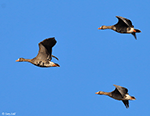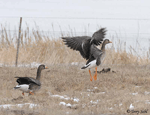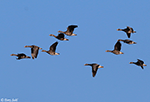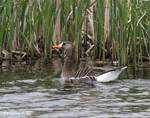| Length: 26 to 34 inches | Wingspan: 54 to 62 inches | Seasonality: Migrant |
| ID Keys: White band at base of pink bill, dark mottling and barring on grayish underparts | ||
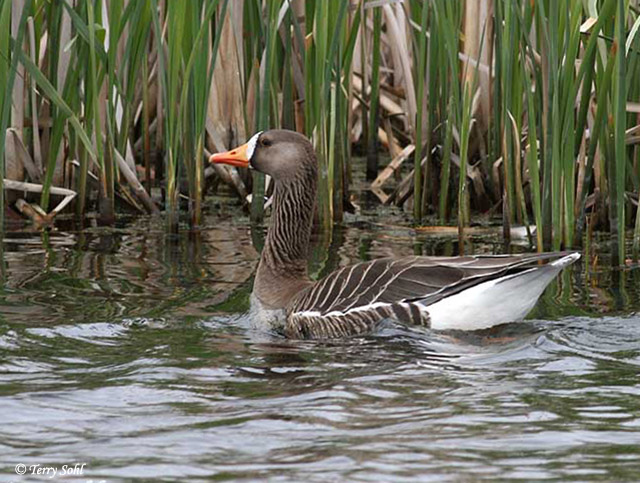 The Greater White-fronted Goose is a common spring migrant in
South Dakota, and can also be found during the fall migration. They have
adapted well to a human presence and now rely heavily on waste grain and other
agricultural by-products on their wintering grounds (and when in migration
through the state).
The Greater White-fronted Goose is a common spring migrant in
South Dakota, and can also be found during the fall migration. They have
adapted well to a human presence and now rely heavily on waste grain and other
agricultural by-products on their wintering grounds (and when in migration
through the state).
Habitat:
Breeds on both wet coastal areas and drier inland areas on the Arctic tundra. In migration and in winter, they are generally found in open habitats where they have easy access to both agricultural fields for feeding and shallow waters for roosting at night.
Diet:
Primarily feeds on grasses, sedges, other plants, berries, and buds in the summer. Relies heavily on seeds and waste grain in the winter, as well as new growth. They will also occasionally feed on snails and aquatic insects.
Behavior:
Often forages on land, walking along and eating food items on the ground. In the water, swims on the surface, reaching its head and neck under the water for food items.
Breeding:
Non-breeder in South Dakota. On their breeding grounds, the nest of a Greater White-fronted Goose is a scrape on the ground, placed in either upland tundra or wetter areas near a pond or wetland. The scrape is lined with grasses, and then finished with downy feathers. The female lays between 2 and 7 eggs, and she alone incubates them. The young hatch after 22 to 27 days.
Family bonds are strong with Greater White-fronted Snow Geese, as mating pairs form long-term bonds and stay together even outside of the nesting season. Young Greater White-fronted Snow Geese will also stay with the parents into the next nesting season.
Song:
High-pitched laughing honk
- Click here to hear the honking of a White-fronted Goose in flight1
- Click here to hear the honking of a group of White-fronted Geese in flight2
- Click here to hear the "nocturnal flight call" of a White-fronted Geese3
Migration:
Summers on the Arctic tundra. Winters locally in California, Washington, Oregon, New Mexico, and Arizona, as well as near the U.S. Gulf Coast and Mexico. They tend to follow established routes and use the same stopover points each season. They are generally only found west of the Mississippi River.
Interactive eBird map:
Click here to access an interactive eBird map of Greater White-fronted Goose sightings
Similar Species:
Greater White-fronted Geese have a unique plumage if seen well, but they could potentially be confused with the following species in poor viewing conditions.
- Snow Goose - With their all-white plumage, the white phase Snow Goose is unlikely to be confused with a Greater White-fronted Goose. However, the dark-phase of a Snow Goose could be confused with a Greater White-fronted Goose. The dark back of the two looks very similar, but a dark-phase Snow Goose has a white head, and more white on its underparts than a Greater White-fronted Goose.
- Canada Goose - The bodies of both geese can look surprisingly similar. The rest of the body is quite different! Canada Goose has a black head and neck with a white chin-strap, while a Greater White-fronted Goose has brownish neck and head, with a white patch in front of the eye. The legs of the two species are also different, with black legs on the Canada Goose, and orange legs on a Greater White-fronted Goose.
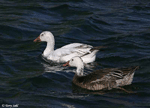 |
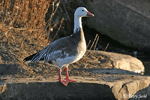 |
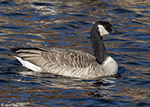 |
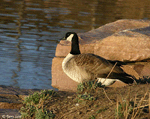 |
| Snow Goose | Snow Goose | Canada Goose | Canada Goose |
Conservation Status:
In the North American part of their range, populations of Greater White-fronted Geese have substantially grown in the last 40 years, in part, rebounding from sharp declines during the first half of the 20th century. They are found across a very broad geographic area, and they are common in many parts of that range. The IUCN considers the Greater White-fronted Goose to be a species of "Least Concern".
Further Information:
- BirdWeb - Greater White-fronted Goose
- WhatBird - Greater White-fronted Goose
- Audubon - Greater White-fronted Goose
Photo Information:
March 20th, 2005 -- Western Minnehaha County -- Terry Sohl
Additional Photos:
Click on the image chips or text links below for additional, higher-resolution Greater White-fronted Goose photos.
Audio File Credits:
- 1Alain Malengreau. Recorded in Belgium on December 19th, 2019. Original recording and information available on xeno-canto.
- 2Bram Vogels. Recorded in Belgium on December 8th, 2020. Original recording and information available on xeno-canto.
- 3Juha Saari. Recorded in Finland on October 4th, 2020. Original recording and information available on xeno-canto.
| Click on the range map for a higher-resolution view |
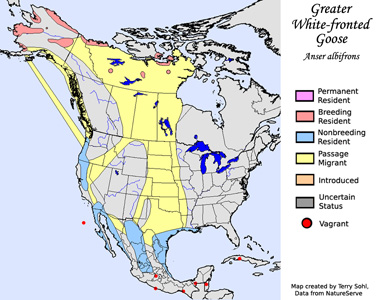 |
| South Dakota Status: Common migrant in the eastern part of the state, less common in the west. |
Additional Greater White-fronted Goose Photos
